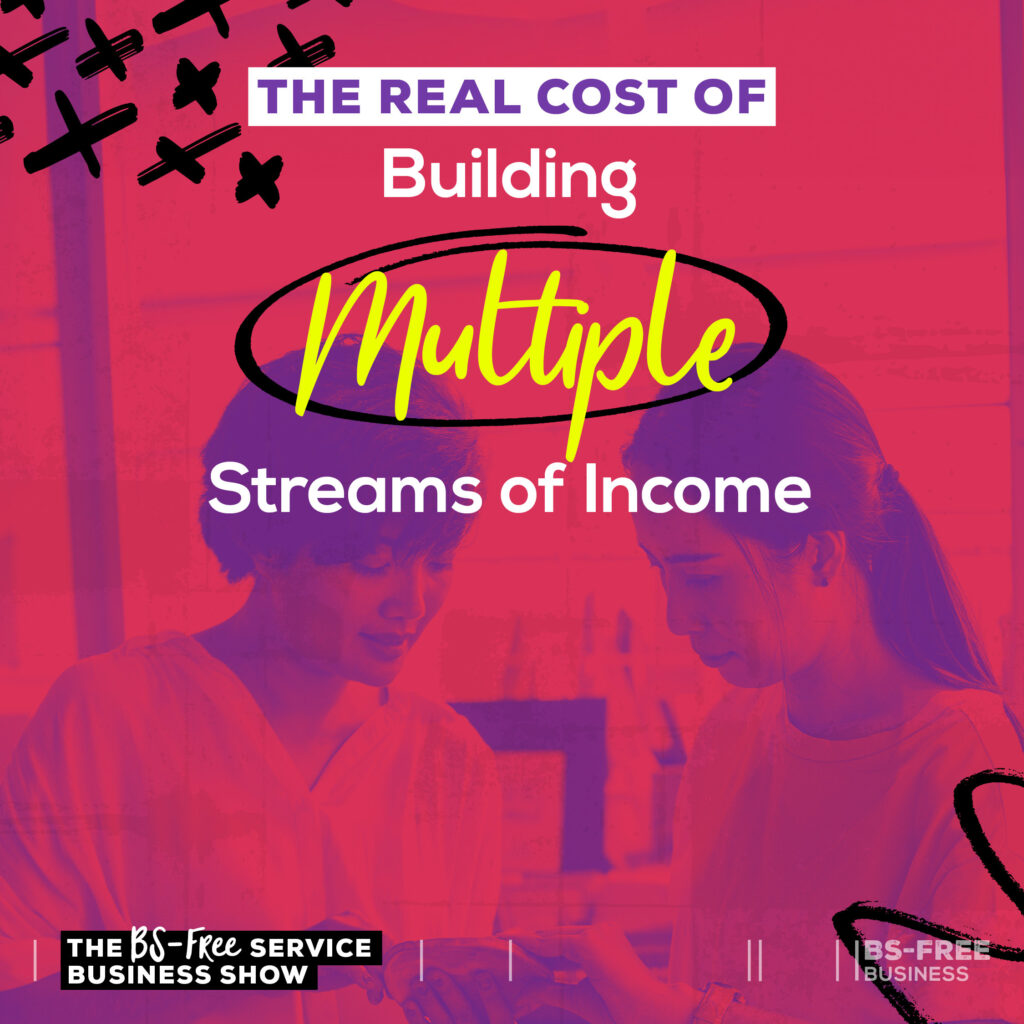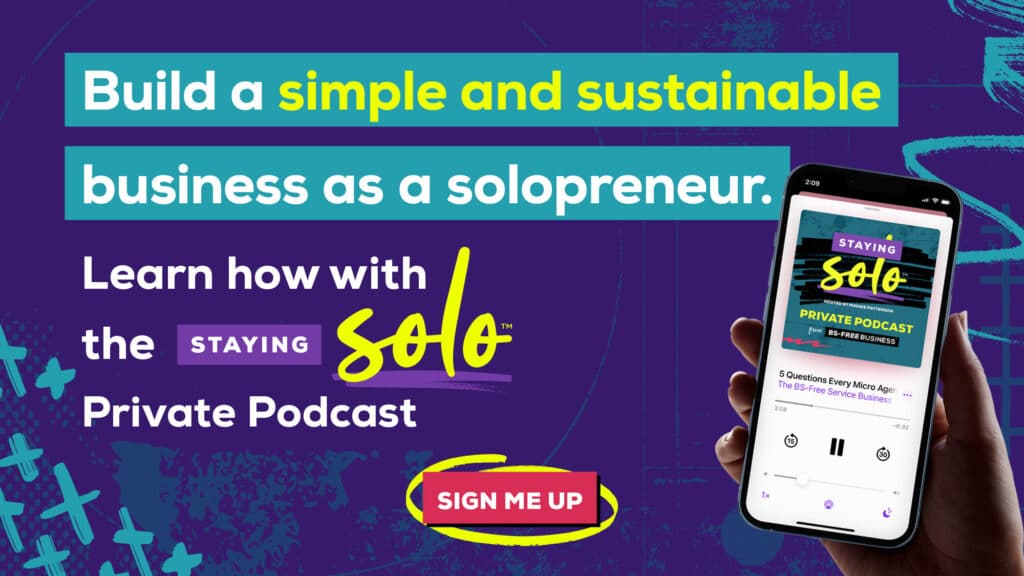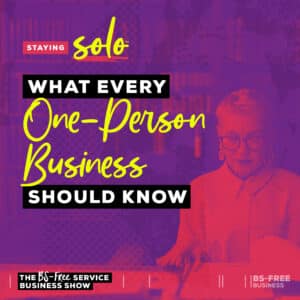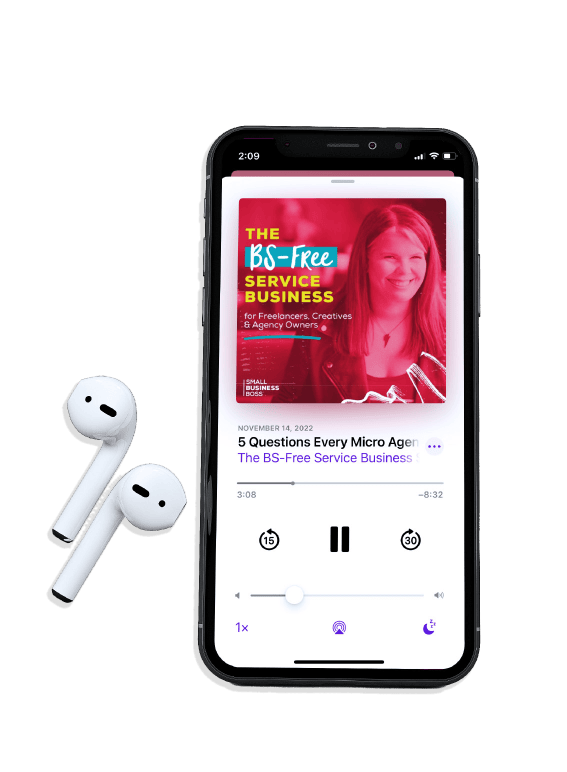
Search the site:
The Real Cost of Building Multiple Streams of Income
If you’ve been running your business for a while, you’ve likely encountered something I call the “service business owner’s dilemma”. You’re busy and booked with clients, but want ways to make more money. Enter adding leveraged, one-to-many offers like courses or group programs as a way of building multiple streams of income.
In this episode, I’m cutting the BS by debunking myths and unveiling the real costs of adding these income streams. Plus, I’m sharing some of my real experiences from launching courses, group programs and more that you won’t want to miss.
Have you ever heard that millionaires have seven income streams? This has long been treated as a fact (even if I can’t find its point of origin) and is used to proactively encourage us to build multiple income streams.
Interestingly, a five-year study of 233 wealthy individuals found that self-made millionaires generated their income from multiple sources, with 65% having three streams of income, 45% having four streams, and 29% having five or more.
The idea is that to be financially successful in conventional terms, we need to have multiple sources of income. But what does that mean for us as service business owners? And what’s the real cost of trying to diversify this way? And is it even worth it?
What Are Multiple Streams of Income?
First, let’s talk about what it means to have multiple income streams. The concept is we should be making money from more than one place at a time to reduce risk and increase financial security.
On a broader scale, these income streams would include our main “job”, as well as income from sources such as investments, dividends, rental properties, affiliate income, side businesses, royalties, real estate trusts, or other means.
In 2024, a lot of the above list is unattainable for most people given the realities of inflation and how salaries have not kept pace. Not everyone has the resources to buy real estate or make investments.
A prime example of this in action is that many people who’ve started side businesses or other projects aren’t doing so to add a revenue stream, they’re doing it to make ends meet. A 2023 survey found that 71% of side hustlers needed the money to survive.
One of the best things about owning your own business is that you have the power to add new revenue streams. That enables you to continue to grow the business in a way that means you’re not relying on a single client or service.
You don’t have to want to be a millionaire to take advantage of this as a business strategy to build stability and mitigate risk. Growing by building multiple income streams enables you to reach new clients, create new opportunities and boost your revenue.
It’s simply smart business. But what I’m going to say next may be surprising for someone who literally has two different businesses
Yes, you should diversify your income streams, but you don’t automatically have to do so using the most common ways taught online. Conventional celebrity entrepreneur wisdom is that you move from one-to-one services to offering a course, coaching, or a group program
Yes, those things have potential as additional revenue streams, but there’s more to it than simply creating and selling it.
There are very real costs involved that go far beyond what learning management platform to choose or designing a sales page. These costs will vary, but it’s critical that you don’t overlook them and remember that just because something worked for one person, it may not work for you.
So much of creating new revenue streams depends on your resources, goals, skills and risk tolerance.
The Service Business Owner’s Dilemma
One of the biggest reasons service business owners want to explore adding new revenue streams is that they feel maxed out with client work.
At some point, you may find yourself unable to take on more clients but want a way to grow your revenue. It’s a classic catch-22 as you need to free up the capacity to grow, and you feel unable to grow as you don’t have the capacity
This is often where you’ll fantasize about another business model being much easier than client services. You’ll consider adding a course or program to make more money, as it can’t be that hard, right
Selling products, whether it be templates, courses, communities, or group programs, is harder than it appears. I’m not going to villainize these as a potential path to building new revenue streams, but just know it will cost you.
Not So Passive Income
While these offers are often pitched as being “passive” they’re anything but, especially when you’re starting out. With the flashy promises of what they can do for your business, it’s so easy to overlook that you need time, energy, and money to get them off the ground.
When you choose this path to diversify your income, you’re, in many ways, starting a second business. When I started what’s now BS-Free Business, it was as part of our agency, and I quickly realized it had to be spun out into its own entity.
Why? Scoop Studios and BS-Free Business are two VERY different businesses. They have different audiences, and the offers must be marketed and managed separately.
That’s not to say you can’t add a course or program to your existing business, but rather, you need to recognize the ways it may require resources you simply don’t have at the moment.
Let’s say you’re overwhelmed with client work but have an idea for a program you’d like to offer. You’re excited and see the revenue potential, but you’re not sure where you’ll find the time, energy and money to make it happen.
That’s where the real cost comes in:
- Can you book one less project this quarter to free up time to work on this?
- Do you have the energetic capacity and skills to build an audience, market, and sell this program?
- Do you have financial resources to invest in the tech, design, copy, or anything else you’ll need to make it a reality?
My Experiences with One-to-Many Offers
In 2015, before I transitioned to the agency model and started BS-Free Business, I launched my “signature” course, No BS Marketing School. I had a reduced client load for much of that year, so I’d have time to create, market, and sell the source.
Plus, I invested about $15k into creating the course. This was before we had learning platforms like Teachable so a full custom membership site was needed.
With the first launch, I made back the money I’d invested and then some. When looking at the money invested, the launch was a success.
This is where I came to understand the hidden costs of this type of revenue stream. I’d spent hours every week working on creating the course content, marketing, and everything else. That time was hard to quantify but definitely was a sunk cost that would take multiple launches to recoup fully.
The other hidden cost was the clients I said no to working with that year. I’ve looked back to find the number as I calculated it at one point, but it was in the $20k to $30k range.
Now, you’re probably thinking, but Maggie, if you continued to launch this course, you’d reap the benefits over time. While you’re not wrong, I also realized that after launching it the second time I kind of hated this “big course” launch model that was everywhere at the time.
The energetic toll of the level of marketing involved was not something I was prepared to sustain long-term. Honestly, that surprised me, but it was an unforeseen cost.
Since then I’ve launched numerous smaller courses, a membership, a shop with on-demand workshops, and at least 15 mastermind groups. Each one had different costs involved, and I’ve been able to refine what works best for me over time.
That said, your experience with building multiple streams of income may be completely different, but I can guarantee there will be costs you’re not expecting.
Now let’s look at some of the most common costs of adding one-to-many offers.
The Balancing Act: Your Time and Energy
When adding a revenue stream that’s focused on the one-to-many model, your business changes. Instead of simply doing client work, you’ll have new demands on your time and energy.
To start, you need to spend time researching and validating your idea right out of the gate. Don’t get so excited about your idea that you completely skip this step. Otherwise, you risk investing your heart and soul into something people don’t want.
Listen, I get it. Many of us are creative people with countless ideas. Not every one of those ideas is meant to be something you sell. Not every one of those ideas deserves your time and energy, even if you’re really enthusiastic about it.
Once you have a viable idea, you need to figure out how to take it to market. What steps are required for you to create and sell this offer?
Be realistic about the time (and energy) required to execute this idea, as you want to ensure it’s not to the detriment of your current clients and current revenue streams.
From there, you need to decide where the time to work on this project will come from and if it’s something you want to pursue. Do you need to lighten your client load? Do you need to do this work outside of normal work hours?
I’m not trying to dash anyone’s dreams; I want to help you realize what this may cost you.
You need to assess if you have the time or want to make the time. Also, do you have the energetic capacity to handle this type of project?
For some of you, the answer may be a resounding yes, and you’re willing to work more hours or give up a client to go after this.
For others, you may have reached this point and now you’re wondering how you can add a revenue stream that’s less time-intensive. (More on that shortly!)
If you’re ready to move forward, I have one last thing for you to think about. Are you willing to stick with this idea for at least a year?
I wish that were a question someone had asked me in early 2015 when I set out to create my course. As business owners, we’re often overly optimistic and expect things to happen faster than they will.
When adding any revenue stream in the one-to-many business model, you’ll need the patience and perseverance to get traction with your offer. No matter what the celebrity entrepreneurs promise, it’s not easy, quick, or passive.
Marketing: You Need to Do the Math
Marketing will always be involved when adding a new revenue stream. I know, there’s no surprise there, but what’s often shocking to many is how much marketing it takes to build an audience and have enough people to sell your offer to.
One of the most pervasive myths in the online business world is the story of “launching to a small list” and getting massive results. I’m going to call bullshit on this story, as it’s been floating around as long as I’ve been in this space.
This tactic may have worked 10+ years ago when there was far less competition. However, this will be exceptionally hard to pull off if you’re in the general space of marketing education or business building. It may be doable if you’re in a very niche area (especially for B2C) with a loyal audience and are first or early to market.
With that out of the way, your email list needs to be bigger than you think to launch anything from a template to a mastermind. To build an engaged community of potential customers, you need ongoing marketing.
The “standard” conversion metric from email subscribers to paying customers is typically 1%. (Don’t ask me where this came from, I’ve tried to track down a source, but this is conventional industry wisdom.) Your conversion rate may be higher, but you can’t automatically assume it will be, especially with your first few launches.
If you’ve created a course and would like 20 people to buy it at a 1% conversion rate, you’ll need an email list of 2000 people. With 3% you’d need 700 people, and at 5% you’d need 400 people.
If you don’t have an email list, it’ll take months (or potentially years) to build it to that size with consistent marketing. Remember, each email is a person. While you may be selling a one-to-many offer, connecting with each person happens individually. And even 400 people are a lot of people to get in front of!
Naturally, this is the point at which you need to consider if you’re game to do this much marketing and if you have the time and skills to do so.
In my case, I’m a content marketer and writer. This type of marketing is a relatively low lift for me regarding needed skills. Even with the necessary skills, my marketing requires ongoing time, and I’m always balancing that between my clients and running the business.
To be transparent, I’m actively focused on growing my audience this year. This means I’m actively working on reaching more people both on social media, the blog, and this podcast, and getting people on to my email list. To make that happen, I’ve created a monthly marketing plan to keep things moving. My core team is all involved in the execution of the plan and we’re investing considerable time into these projects.
Your marketing will be an ongoing project, so you need to ensure it’s something you want to do. You need to make a well-informed choice about how your focus will shift as you add new income streams, especially if they sell a one-to-many offer.
Counting the Costs: Evaluating Financial Implications
Now, let’s discuss the financial costs of adding these revenue streams. As I shared in the recent episode on tools, your business model and who your clients are will absolutely impact which ones you use.
One of my favorite things about working one-on-one with clients is that you don’t need many tools, and most of the tech you use is related to your actual type of work.
Let’s say you want to create a template shop. You’ll need a platform to sell and deliver those templates. My shop is built on Shopify which is connected with Teachable and ConvertKit.
These platforms have ongoing costs, so you need to assess if it’s worth it. If your
tech stack costs you $750 per year, and you’re averaging $6000 per year in sales, you’re likely ahead of the game. But if you sell $1000 a year of templates and it’s costing you $750 for the tech, you may find easier ways to make that money.
Beyond the tool costs, you need to factor in processing fees and any professional services you need (like design, copy, tech setup, legal). Some of these items you can absolutely DIY, but I don’t recommend you skip the legal. You’ll want your intellectual property protected and clear terms and conditions for your customers.
Finally, additional operational costs may be hard to predict but will add to your total expenses.
The Realities of Opportunity Cost
The last cost I want to touch on is the opportunity cost, which you lose when selecting one option over another.
When you add a new revenue stream, you may do that instead of working with your clients. Or end up adding extra work hours to your schedule. That’s the opportunity cost.
That’s not necessarily bad, but it should factor into your decision-making as you consider your options. It’s easy to glamorize what your business will look like if you add a course or program, but please ensure you understand what you’re getting into and what you may be giving up.
Ask yourself what the tradeoff will be to pursue any potential new revenue streams.
Building Multiple Streams of Income (Without Changing Your Business Model)
Perhaps you’ve decided you’re up for the challenge of building multiple income streams with a one-to-many offer. If that’s the case, I’d encourage you to go back and review everything shared in this episode with a pen and notebook so you can map out what’s required to move forward.
Conversely, what if you’ve decided that’s not the right move for you? Can you still add new income streams?
The answer is YES. There are ways you can do this within your business that don’t require you to switch away from the service business model.
Look for ways to innovate and iterate within your existing services to see where you have the potential to add new revenue.
A few questions you can explore:
- Are you currently selling strategy?
- How can you add a different delivery model into the mix?
- What services can you easily productize and sell?
- Can you add consulting-specific projects or offers?
There’s always a way to build on what you’re already offering to capture interest from new potential clients or a different segment of the market. The key is getting creative about how you can do that without being enticed by the idea that another business model will be simpler for you.
As we wrap up this episode, consider your motivations for adding additional income streams, and be willing to challenge conventional wisdom to determine what will work best for you.
Whether you decide to stick with services or add on a one-to-many revenue stream, you’ll need a lot of patience and realistic expectations about the costs involved.
Links for this episode:
- Author Who Studies Millionaires: How to Create Wealth Like the Rich
- Survey: Side Hustle Stress
- BS-Free Masterminds
- Duped: The Grift of Audience Growth
- The Real Cost of Tech and Tools for Solopreneurs
- BS-Free Shop
- The Aligned Service Business Model
- Sell the Strategy: Stepping Up Your Service Business
- What You Need to Know About Done-For-You Vs. Coaching-Based Business Models


I’m Maggie Patterson (she/her), and services businesses are my business.
I have 20+ years of experience with client services, am a consultant for agency owners, creatives, and consultants, and vocal advocate for humane business practices rooted in empathy, respect, and trust.
Help Not Hype

Tired of the same old BS business advice?
I got you with weekly emails packed full of proven strategy that makes a real difference in your service business.









